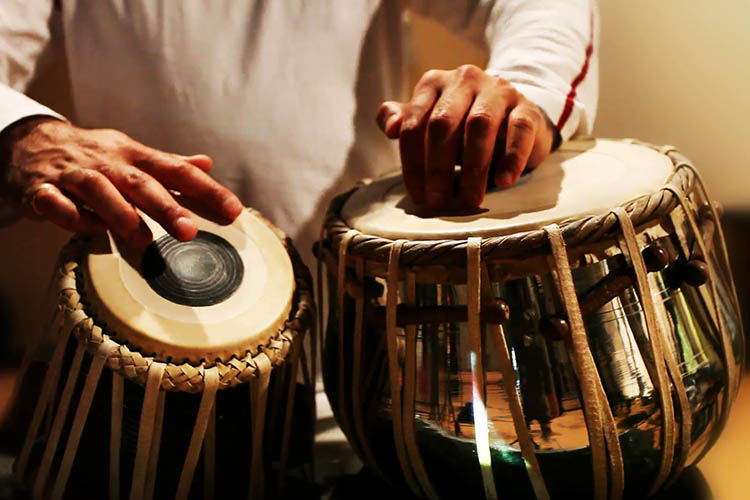TABLA

Tabla Classes in Surat to learn Tabla for Beginners Near Me
Naad Academy is the best Tabla classes in Surat for beginners near your location in Surat, Gujarat, India. So, If you are interested to learn Tabla, or just want to see if it is the right instrument for you, we give both individual and group learning experiences; lessons for beginners and for experienced players. Also, his Workshops are a one day activity that could be perfect to have a full day experience with this instrument and will give the possibility to explore a little deeper, giving you the chance to feel if it’s an instrument for you.
THE TABLA is regarded as the queen of drums and percussion instruments and is the most popular Indian rhythm instrument. It consists of two drums, the smaller drum is termed dayan and is made of wood and is played with the right hand. The larger deeper-pitched drum is made of metal and is known as bayan. Both drums have goat or cow skin covering. They have a black middle spot made of iron fillings, soot and gum which produces a characteristic bell-like sound when drummed. The combination of the two drums produces an incredible fullness and details of different rhythm structures and this fullness of expression is unmatched by any other rhythm instrument. No other percussion instrument has as many combination possibilites as tabla.
THE LESSONS aim at developing the correct technique and tone quality to allow students to create their own music and their own improvisations as tabla players while maintaining the sublime tradition of Indian tabla. Incorporating a modern approach, the lessons are based on the traditional training Manish received in India. In learning the instrument, all tabla students learn the spoken rhythms of the tabla known as tabla bols. According to each student’s needs, lessons cover many aspects of tabla playing, including grooves and creative accompaniment, improvisation and expression as well as the more detailed and advanced techniques.
Each Tabla drum stroke can be expressed by a corresponding syllable, used for both teaching and performance purposes. The intricate music of the Tabla drums reflects the rhythmic framework (tala) of the piece. Some basic strokes with dayan Tabla drum on right side and bayan Tabla drum on left side are:
- Ta: (on dayan Tabla drum) striking sharply with the index finger against the rim.
- Ghe or Ga: (on bayan Tabla drum) holding wrist down and arching the fingers over the syahi, the middle and ring-fingers then strike the maidan (resonant).
- Thin: (on dayan Tabla drum) placing the last two fingers of the right hand lightly against the syahi and striking on the border between the syahi and the maidan (resonant).
- Dha: combination of Ta and Ghe.
- Dhin: combination of Tin and Ghe.
- Ka or Kath: (on bayan Tabla drum) striking with the flat palm and fingers (non resonant).
- Na or Ta: (on dayan Tabla drum) striking the edge of the syahi with the last two fingers of the right hand.
- Tete: (on dayan Tabla drum) striking the center of the syahi with the middle finger.
- Ti: (on dayan Tabla drum) striking the center of the Tabla syahi with the index finger (resonant).
Playing Taals On Tabla:
Some tals, for example Dhamaar, Ek, Jhoomra and Chau tals, lend themselves better to slow and medium tempos. Others flourish at faster speeds, like playing Jhap tal or Rupak talas. Trital or Teental is one of the most popular, since it is as aesthetic at slower tempos as it is at faster speeds. Indian classical Hindustani music has many Taals, some of the more popular music Taals are: Tintal (or Trital or Teental), Jhoomra, Tilwada, Dhamar, Ektaal and Chautal, Jhaptal, Keherwa taal, Rupak (Mughlai/Roopak), Dadra taal. The rarer Taals in Hindustani classical music are: Adachoutal, Brahmtal, Dipchandi, Shikar, Sultal, Pancham Savari, Gaj jhampa etc.
Students will need to have their own tabla and a desire to participate in live online learning with one of the most promising tabla players of his generation, Unmesh Banjeree. Each student will benefit from Unmesh’s lifelong experience and his willingness to tailor the course to his students’ age and learning style. This customization will increase retention and enjoyment for any student. By the end of the 13 weeks, Basic Tabla for Beginners will have provided a strong foundation of knowledge and technique from which students can grow and build on. After successful completion of this course, students can gear themselves for the next course by our experts: Tabla Lessons for Advanced Students and Learning Classical Indian Rhythm | Konnakol.
